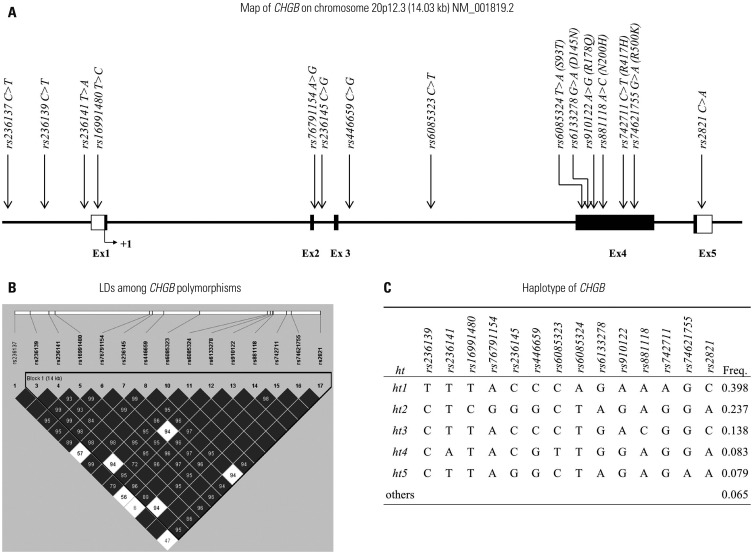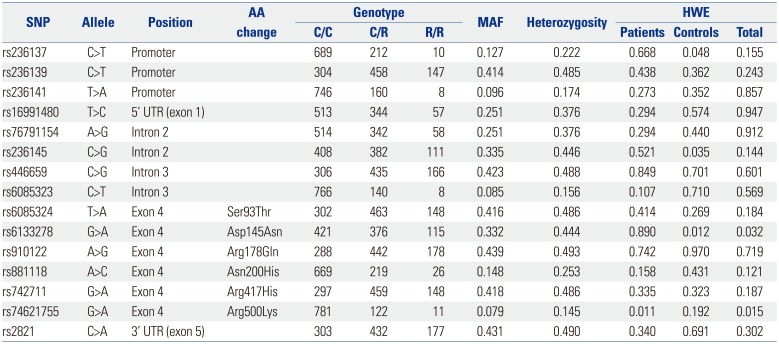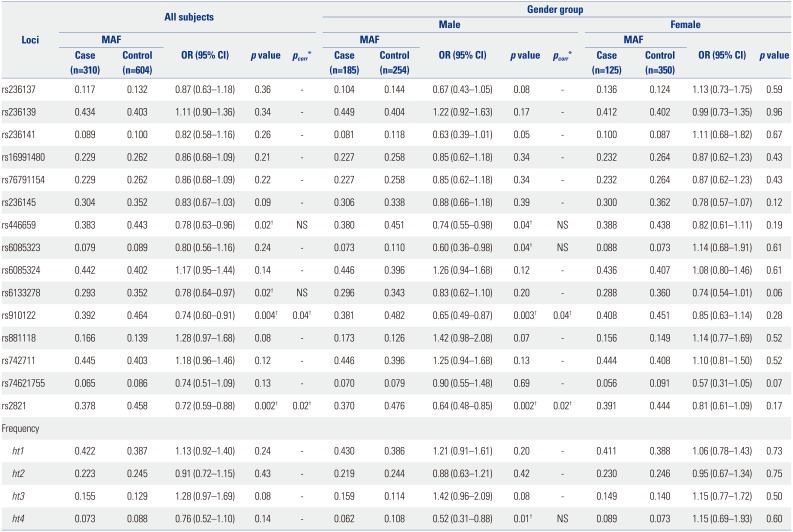1. Picchioni MM, Murray RM. Schizophrenia. BMJ. 2007; 335:91–95. PMID:
17626963.

2. Aleman A, Kahn RS, Selten JP. Sex differences in the risk of schizophrenia: evidence from meta-analysis. Arch Gen Psychiatry. 2003; 60:565–571. PMID:
12796219.
3. Ochoa S, Usall J, Cobo J, Labad X, Kulkarni J. Gender differences in schizophrenia and first-episode psychosis: a comprehensive literature review. Schizophr Res Treatment. 2012; 2012:916198. PMID:
22966451.

4. van Os J, Kapur S. Schizophrenia. Lancet. 2009; 374:635–645. PMID:
19700006.

5. Owen MJ, Craddock N, O'Donovan MC. Schizophrenia: genes at last? Trends Genet. 2005; 21:518–525. PMID:
16009449.

6. Chen XW, Feng YQ, Hao CJ, Guo XL, He X, Zhou ZY, et al. DTNBP1, a schizophrenia susceptibility gene, affects kinetics of transmitter release. J Cell Biol. 2008; 181:791–801. PMID:
18504299.

7. Gamo NJ, Duque A, Paspalas CD, Kata A, Fine R, Boven L, et al. Role of disrupted in schizophrenia 1 (DISC1) in stress-induced prefrontal cognitive dysfunction. Transl Psychiatry. 2013; 3:e328. PMID:
24301646.

8. Harrison PJ, Law AJ. Neuregulin 1 and schizophrenia: genetics, gene expression, and neurobiology. Biol Psychiatry. 2006; 60:132–140. PMID:
16442083.

9. Iijima Y, Inada T, Ohtsuki T, Senoo H, Nakatani M, Arinami T. Association between chromogranin B gene polymorphisms and schizophrenia in the Japanese population. Biol Psychiatry. 2004; 56:10–17. PMID:
15219467.

10. Wu S, Ma J, Xing Q, Xu Y, Meng J, Cao D, et al. Further evidence that the chromogranin B gene confers predisposition to schizophrenia: a family-based association study in Chinese. J Neural Transm (Vienna). 2007; 114:641–644. PMID:
17143778.

11. Kitao Y, Inada T, Arinami T, Hirotsu C, Aoki S, Iijima Y, et al. A contribution to genome-wide association studies: search for susceptibility loci for schizophrenia using DNA microsatellite markers on chromosomes 19, 20, 21 and 22. Psychiatr Genet. 2000; 10:139–143. PMID:
11204350.

12. Nowakowski C, Kaufmann WA, Adlassnig C, Maier H, Salimi K, Jellinger KA, et al. Reduction of chromogranin B-like immunore-activity in distinct subregions of the hippocampus from individuals with schizophrenia. Schizophr Res. 2002; 58:43–53. PMID:
12363389.

13. Zhang B, Tan Z, Zhang C, Shi Y, Lin Z, Gu N, et al. Polymorphisms of chromogranin B gene associated with schizophrenia in Chinese Han population. Neurosci Lett. 2002; 323:229–233. PMID:
11959426.

14. American Psychiatric Association. Diagnostic and Statistical Manual of Mental Disorders: DSM-IV. Washington, DC: American Psychiatric Association;1994.
15. Barrett JC, Fry B, Maller J, Daly MJ. Haploview: analysis and visualization of LD and haplotype maps. Bioinformatics. 2005; 21:263–265. PMID:
15297300.

16. Stephens M, Smith NJ, Donnelly P. A new statistical method for haplotype reconstruction from population data. Am J Hum Genet. 2001; 68:978–989. PMID:
11254454.

17. Nyholt DR. A simple correction for multiple testing for single-nucleotide polymorphisms in linkage disequilibrium with each other. Am J Hum Genet. 2004; 74:765–769. PMID:
14997420.

18. Seeman P, Kapur S. Schizophrenia: more dopamine, more D2 receptors. Proc Natl Acad Sci U S A. 2000; 97:7673–7675. PMID:
10884398.

19. Zheng W, Wang H, Zeng Z, Lin J, Little PJ, Srivastava LK, et al. The possible role of the Akt signaling pathway in schizophrenia. Brain Res. 2012; 1470:145–158. PMID:
22771711.

20. Landén M, Grenfeldt B, Davidsson P, Stridsberg M, Regland B, Gottfries CG, et al. Reduction of chromogranin A and B but not C in the cerebrospinal fluid in subjects with schizophrenia. Eur Neuropsychopharmacol. 1999; 9:311–315. PMID:
10422891.

21. Lechner T, Adlassnig C, Humpel C, Kaufmann WA, Maier H, Reinstadler-Kramer K, et al. Chromogranin peptides in Alzheimer's disease. Exp Gerontol. 2004; 39:101–113. PMID:
14724070.

22. Nilsson A, Fälth M, Zhang X, Kultima K, Sköld K, Svenningsson P, et al. Striatal alterations of secretogranin-1, somatostatin, prodynorphin, and cholecystokinin peptides in an experimental mouse model of Parkinson disease. Mol Cell Proteomics. 2009; 8:1094–1104. PMID:
19131325.

23. Zhang K, Biswas N, Gayen JR, Miramontes-Gonzalez JP, Hightower CM, Mustapic M, et al. Chromogranin B: intra- and extra-cellular mechanisms to regulate catecholamine storage and release, in catecholaminergic cells and organisms. J Neurochem. 2014; 129:48–59. PMID:
24266713.

24. Schizophrenia Working Group of the Psychiatric Genomics Consortium. Biological insights from 108 schizophrenia-associated genetic loci. Nature. 2014; 511:421–427. PMID:
25056061.
25. Maric NP, Svrakic DM. Why schizophrenia genetics needs epigenetics: a review. Psychiatr Danub. 2012; 24:2–18. PMID:
22447077.
26. Taupenot L, Harper KL, O'Connor DT. The chromogranin-secretogranin family. N Engl J Med. 2003; 348:1134–1149. PMID:
12646671.

27. Kegeles LS, Abi-Dargham A, Frankle WG, Gil R, Cooper TB, Slifstein M, et al. Increased synaptic dopamine function in associative regions of the striatum in schizophrenia. Arch Gen Psychiatry. 2010; 67:231–239. PMID:
20194823.

28. Saria A, Troger J, Kirchmair R, Fischer-Colbrie R, Hogue-Angeletti R, Winkler H. Secretoneurin releases dopamine from rat striatal slices: a biological effect of a peptide derived from secretogranin II (chromogranin C). Neuroscience. 1993; 54:1–4. PMID:
8515836.

29. Ren J, Jiang C, Gao X, Liu Z, Yuan Z, Jin C, et al. PhosSNP for systematic analysis of genetic polymorphisms that influence protein phosphorylation. Mol Cell Proteomics. 2010; 9:623–634. PMID:
19995808.

30. Savas S, Ozcelik H. Phosphorylation states of cell cycle and DNA repair proteins can be altered by the nsSNPs. BMC Cancer. 2005; 5:107. PMID:
16111488.

31. Ryu GM, Song P, Kim KW, Oh KS, Park KJ, Kim JH. Genome-wide analysis to predict protein sequence variations that change phosphorylation sites or their corresponding kinases. Nucleic Acids Res. 2009; 37:1297–1307. PMID:
19139070.

32. Langouët M, Saadi A, Rieunier G, Moutton S, Siquier-Pernet K, Fernet M, et al. Mutation in TTI2 reveals a role for triple T complex in human brain development. Hum Mutat. 2013; 34:1472–1476. PMID:
23956177.

33. Chaudhary MW, Al-Baradie RS. Ataxia-telangiectasia: future prospects. Appl Clin Genet. 2014; 7:159–167. PMID:
25258552.
34. Gururajan A, van den Buuse M. Is the mTOR-signalling cascade disrupted in Schizophrenia? J Neurochem. 2014; 129:377–387. PMID:
24266366.

35. Jaros JA, Martins-de-Souza D, Rahmoune H, Rothermundt M, Leweke FM, Guest PC, et al. Protein phosphorylation patterns in serum from schizophrenia patients and healthy controls. J Proteomics. 2012; 76 Spec No.:43–55. PMID:
22641159.

36. Canuso CM, Pandina G. Gender and schizophrenia. Psychopharmacol Bull. 2007; 40:178–190. PMID:
18227787.
37. Ram Murthy A, Purushottam M, Kiran Kumar HB, ValliKiran M, Krishna N, Jayramu Sriharsha K, et al. Gender-specific association of TSNAX/DISC1 locus for schizophrenia and bipolar affective disorder in South Indian population. J Hum Genet. 2012; 57:523–530. PMID:
22673686.

38. Mukai J, Liu H, Burt RA, Swor DE, Lai WS, Karayiorgou M, et al. Evidence that the gene encoding ZDHHC8 contributes to the risk of schizophrenia. Nat Genet. 2004; 36:725–731. PMID:
15184899.

39. Zhang K, Rao F, Rana BK, Gayen JR, Calegari F, King A, et al. Autonomic function in hypertension; role of genetic variation at the catecholamine storage vesicle protein chromogranin B. Circ Cardiovasc Genet. 2009; 2:46–56. PMID:
20011129.
40. Castle D, Sham P, Murray R. Differences in distribution of ages of onset in males and females with schizophrenia. Schizophr Res. 1998; 33:179–183. PMID:
9789910.









 PDF
PDF ePub
ePub Citation
Citation Print
Print


 XML Download
XML Download